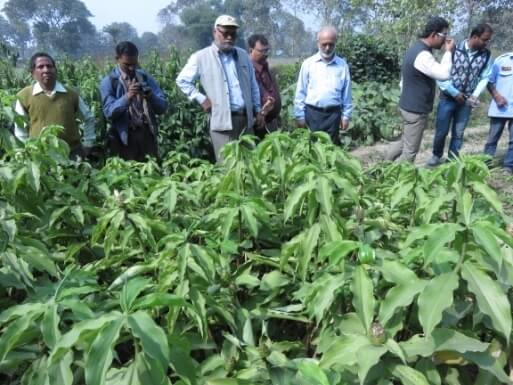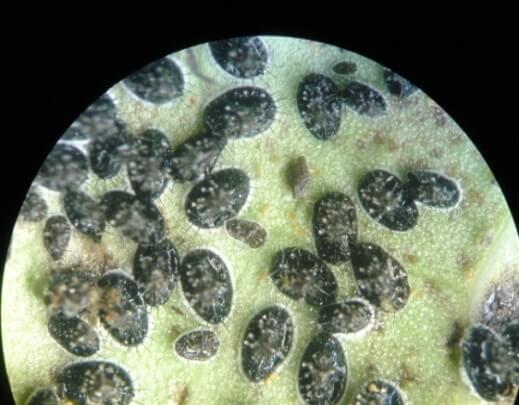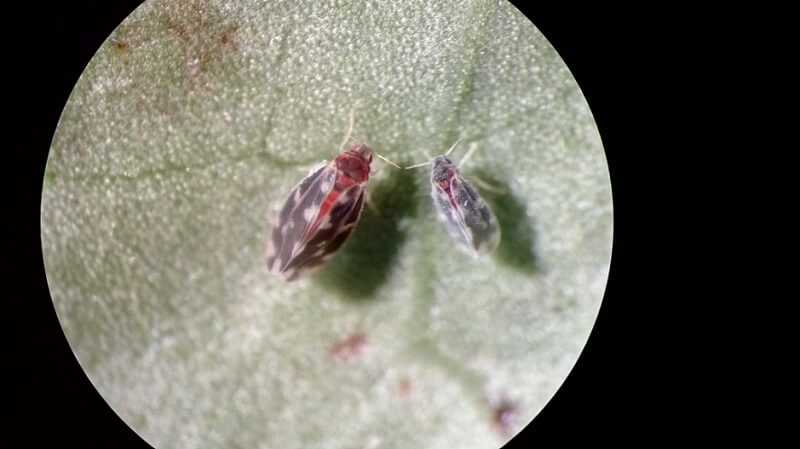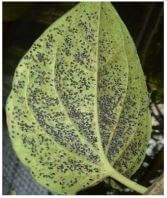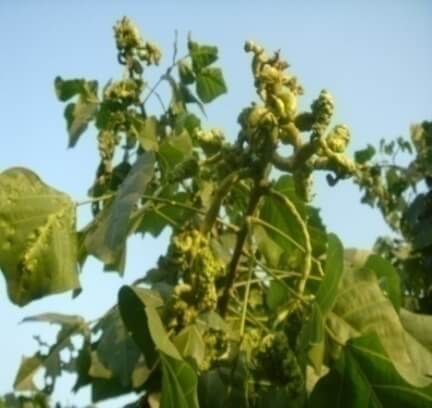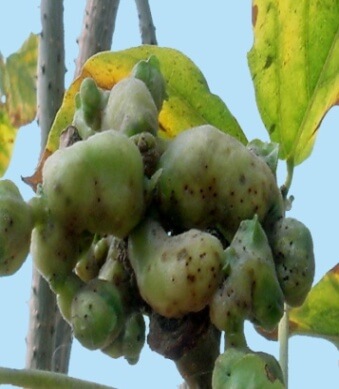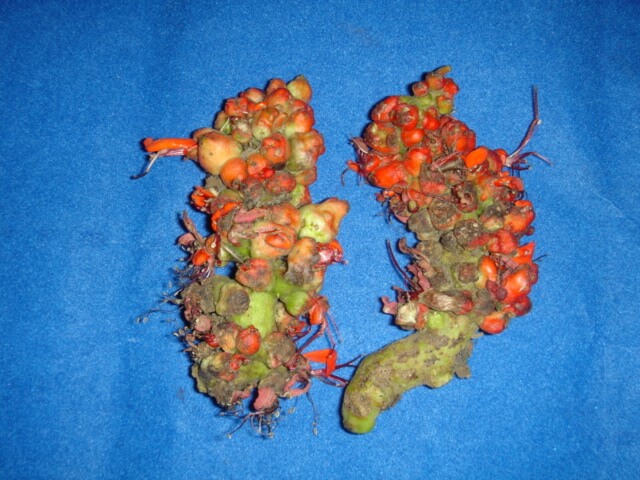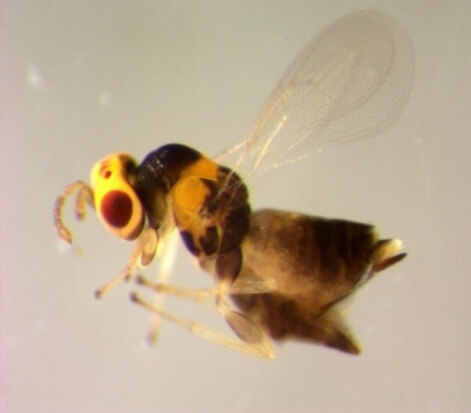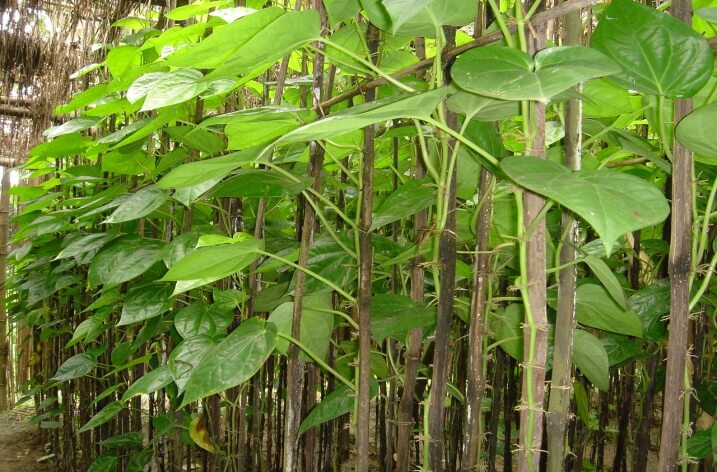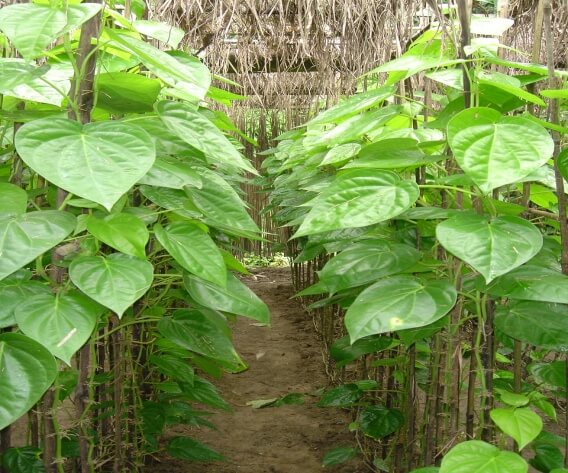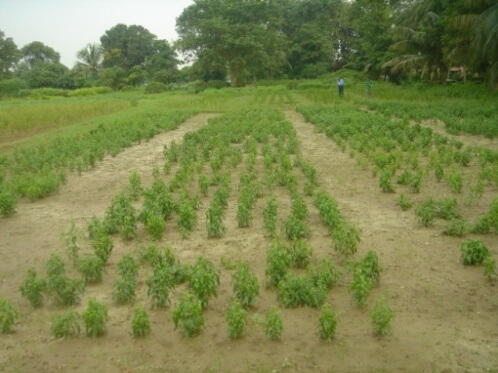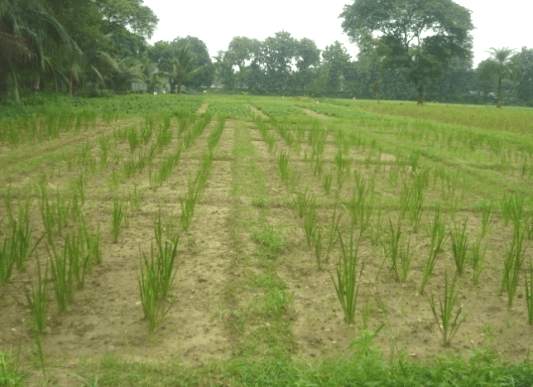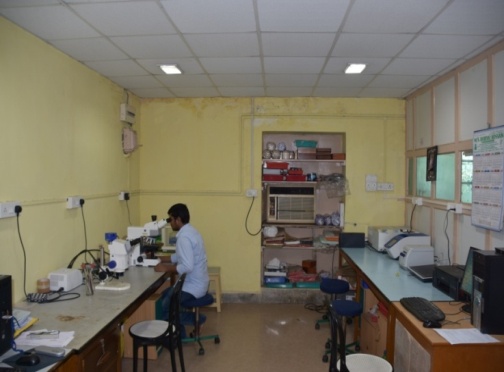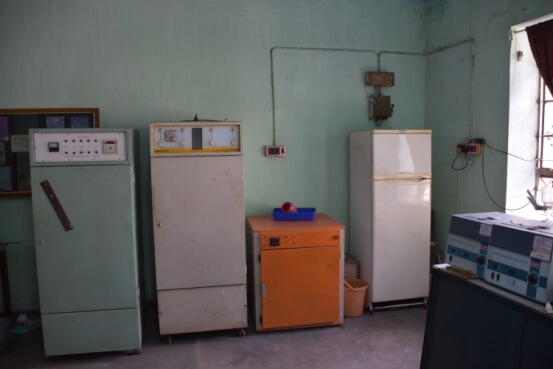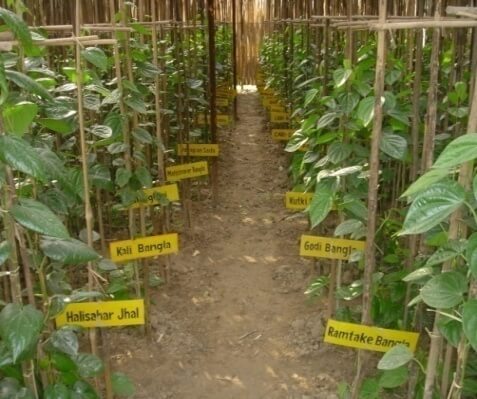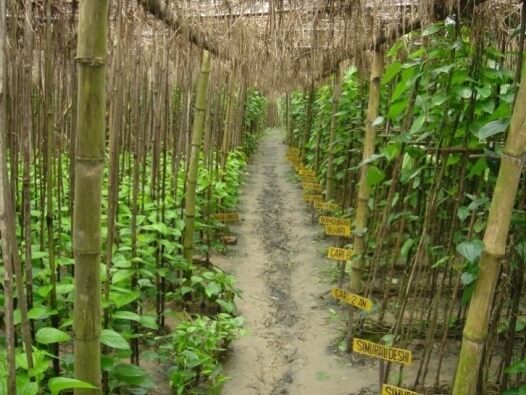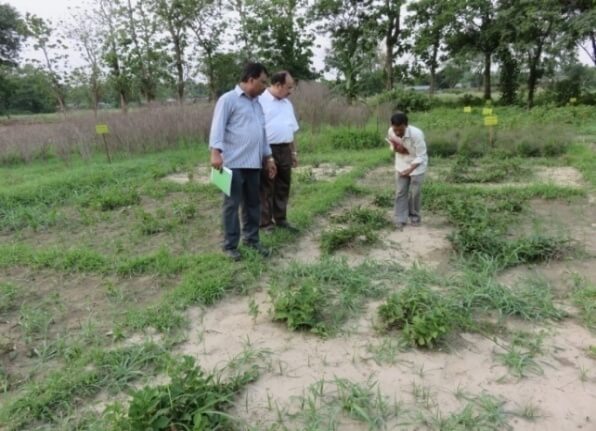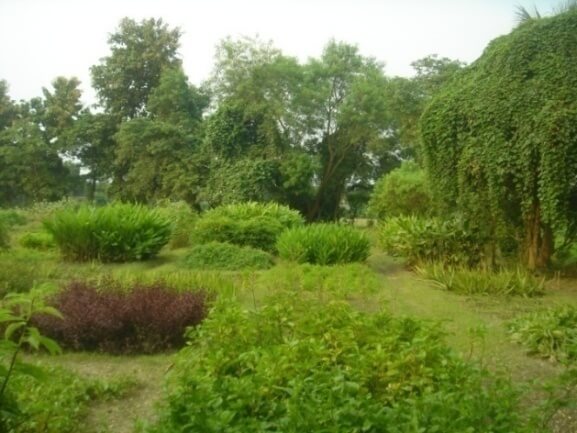AINP on Medicinal and Aromatic Plants & Betelvine
Considering the tremendous potentiality of Betelvine, Indian Council of Agricultural Research (ICAR) extended its hand for research on betelvine by creating a new All India Coordinated Research Project (AICRP) in 1981 under Crop Science division initially with six centres. The project was initially started as a disease management programme (AICRP on Betelvine Diseases). BCKV, Kalyani was included as a centre of this AICRP in 1983, and it started functioning in 1984 with three scientist posts. In the VIII Plan, the project was shifted from the Crop Science division to Horticulture division of the Council and the project objectives was slightly modified with the inclusion of other activities such as crop improvement, crop production, other components of crop protection and post harvest technology and thereby changing its name to AICRP on Betelvine. In the Xth Plan (2002-2007), AICRP on Betelvine was converted in to All India Net-Working Project (AINP on Betelvine) as per the recommendation of the Jain Committee. In the XI Plan, ICAR took a decision to merge two projects (AINP on MAP & AINP on Betelvine) into one AICRP giving the name AICRP on MAP & Betelvine to give a new dimension of Betelvine crop integrating with the Indian System of Medicine. As a result, the AICRP on MAP and Beteivine has now 22 centers which are coordinated from the Directorate of Medicinal and Aromatic Plant Research. The first Workshop of AICRP on MAP and Beteivine was held at MPKV, Rahuri during November 8-11, 2010. For maintenance of betelvine germplasm, BCKV centre has been chosen for germplasm hub particularly for Bangla type cultivars.
Year of start/establishment of the Project: 1984
Staff Strength (Scientific/Technical or Supporting) in Full Details:
| Name | Designation |
|---|---|
| Prof. Bijan Kr. Das | Professor of Agril. Entomology & Officer Incharge |
| Dr. Goutam Mondal | Associate Professor (Plant Pathology) |
| Dr. Pran Krishna Thakur | Assistant Professor (Horticulture) |
| Sri Krishanu Sarkar | Jr. Assistant |
| Sri Tapan Kr. Dam | Driver (Light) |
| Sri Kuno Soren | Jr. Mali |
| Mrs. Ranibala Mondal | Jr. Mali |
Infrastructure Available:
- No. of Boraj: 5 nos.
- Medicinal Plant Garden: 1 no.
- No. of Agro-shed Net House: 2 nos.
- Laboratory Instruments: Light Research Microscope (1 nos.), Stereo Microscope (2 nos.), BOD (4 nos.), Laminar Air Flow Chamber (1 nos.), UV-VIS Spectrophotometer (1 no.), Auto-Clave and Centrifuge (1no.)
Mandate/Objectives:
Betelvine
- Collection, maintenance and evaluation betelvine germplasm (mainly Bangla cultivars)
- To appraise the pest and disease situation of betelvine in West Bengal.
- To identify source of resistance to the pests and diseases by collecting and testing the available germplasm in different parts of the country.
- Development of integrated pest and disease management protocols.
- To develop agro-technique for the development of effective and economically viable betelvine culture.
Medicinal and Aromatic Plants
 Sarpagandha
Sarpagandha
Rouvolfia sepentina Benth ex. Kutz. Kalmegh
Kalmegh
Andrographis paniculate Pen. Pipul
Pipul
Piper longum L. Thankuni
Thankuni
Centella asiatica (L.) Urban Brahmi
Brahmi
Bacopa monnieri (L.) Pennell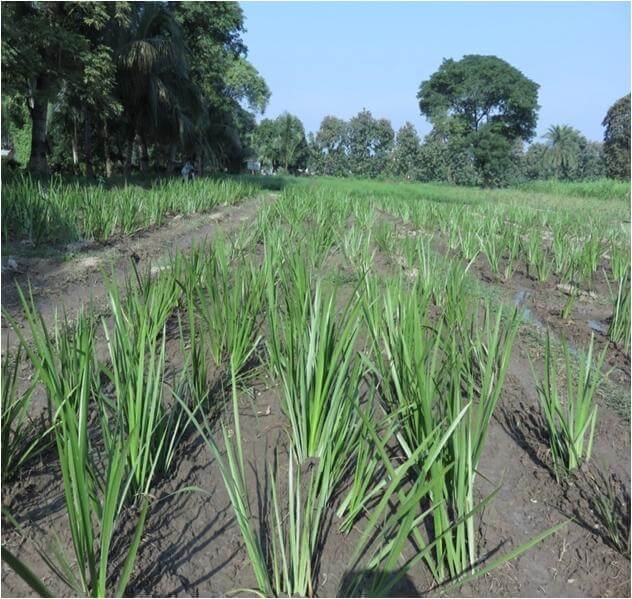 Bach
Bach
Acorus calamus L.
The major objectives of Medicinal and Aromatic Plants research for this centre:
- Collection and maintenance of germplasms of medicinal plants with special emphasis on Kalmegh (Andrographis paniculata), Bach (Acorus calamus), Sarpagandha (Rouvolfia sepentina), Pipul (Piper longum), Brahmi (Bacopa monnieri) and Thankuni (Centella asiatica).
- Development of agrotechniques for Kalmegh Sarpagandha, Pipul and Thankuni
- Survey of pests & diseases of medicinal plants
- To assess the economic impact of insect pests & diseases on the production of medicinal plants.
- To study the seasonality and biology of important insect pests and pathogens of medicinal plants and their management.
Salient Findings:
Betelvine
- New variety: One clonal selection from Bangla cultivar ‘Ghanagette’ has been identified as high yielder and recommended for release in West Bengal as ‘Bidhan Pan-1’
- Major biological stress in betel vine cultivation in W.B. have been identified:
- Diseases: Foot rot and leaf rot caused by Phytophthoranicotianae , Basal rot caused by Sclerotium rolfsii, Leaf spot disease caused by Colletotrichum capsici and Xanthomonas campestris pv. Beticola
- Insect and mite pests: whitefly Singhiella pallida (Singh), blackfly, Aleurocanthus rugosa Singh,Mite, Brevipalpus phoenicis
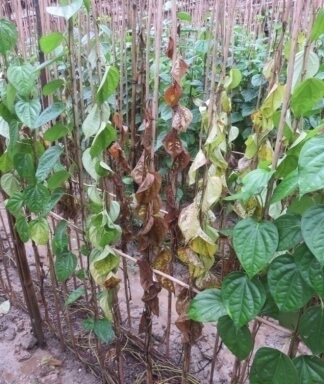 Foot and leaf rot by Phytophthora nicotianae
Foot and leaf rot by Phytophthora nicotianae
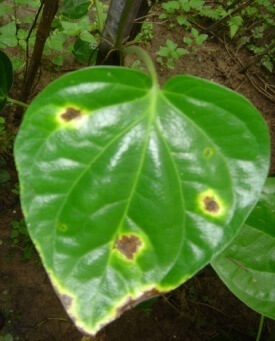 Leaf spot by Colletorichum capsici
Leaf spot by Colletorichum capsici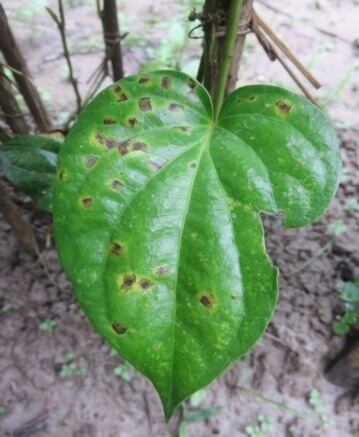 Bacterial leaf spot: X. c. pv. betlicola
Bacterial leaf spot: X. c. pv. betlicola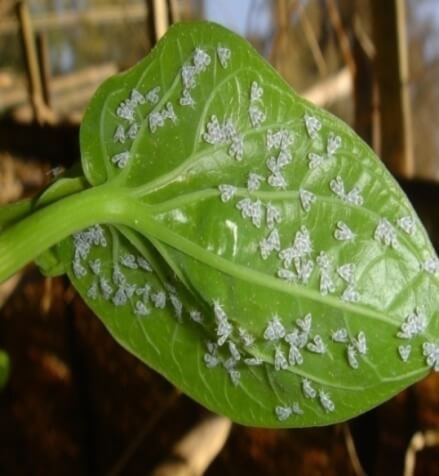 Whitefly adults (Singhiella pallida)
Whitefly adults (Singhiella pallida)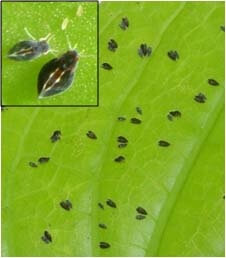 Black fly adults (Aleurocanthus rugosa)
Black fly adults (Aleurocanthus rugosa)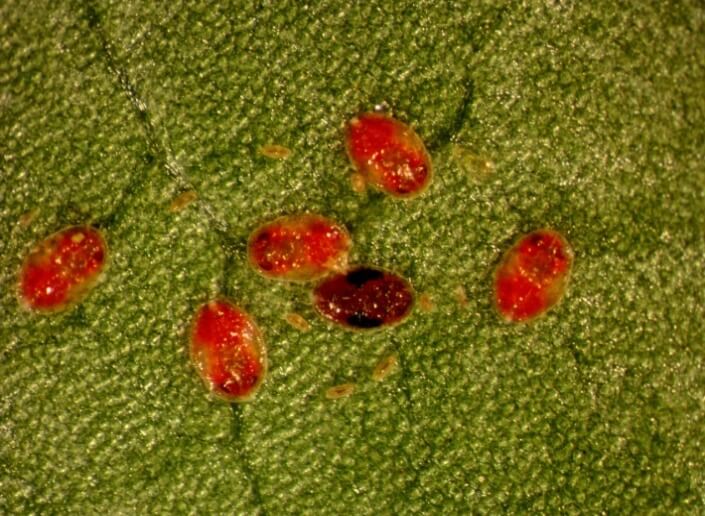 Blackfly nymphs & puparia
Blackfly nymphs & puparia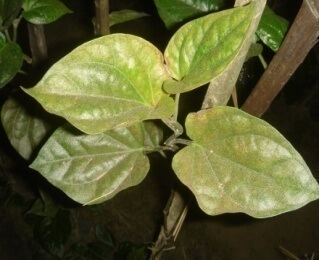 Mite (Brevipalpus phoenicis) infested leaf
Mite (Brevipalpus phoenicis) infested leaf
- Sources of Resistance against pests & diseases identified
- ‘Halisar Sanchi’ - resistant to multiple diseases such as foot rot, leaf rot, anthracnose and bacterial leaf spot
- Kalipatti, Simurali Sanchi, Halisahar Sanchi -- resistant to whitefly,Singhiella pallida
- CARI- 2 (AN), CARI-6(AN) and Bilhari - moderately resistance against blackfly, Aleurocanthus rugosa.
- Standardization of Inoculum for Mass Multiplication of Trichoderma has been done. Wheat can be used as substrate for the production of mass culture of T. harzianum. Trichoderma spore production was maximum when 60g of culture was inoculated in 10kg of de-oiled mustard cake or groundnut oil cake and incubated for 60 days. The spore concentration decreased as the days of incubation period increased.
- Trichoderma sp. applied at 107 CPU remains in the soil upto 90 days at same CPU, then CPU of Trichoderma sp. decreases below 107 CPU). Trichoderma sp should be applied in soil at 90 days intervals to obtain the optimum efficacy to control the major fungal diseases of betelvine.
- Detail biologies of betelvine blackfly - Aleurocanthus rugosa, whitefly - Singhiella pallida and blackfly - Aleurocanthus bucktoni (Aleyrodidae: Hemiptera) on betelvine have been worked out.
- New Pests and parasitoids on Betelvine:
- a) In betelvine, one new aleyrodid fly, Aleurocanthus bucktoni Sundararaj & Pushpa (Aleyrodidae: Hemiptera) has been recorded on betelvine from Kalyani, West Bengal.
- An internal parasitoid of Aleurocanthus rugosa Singh has been identified as a species of Eretmocerus Haldeman (Hymenoptera: Aphelinidae: Aphelininae).
Medicinal and Aromatic Plants:
- Promising lines of Kalmegh, INGR07041 (4733kg/ha) and Bach, Aihagaripalli (3.96 t/ha) for high yield have been identified.
- Development of agro-techniques for Kalmegh: The proper spacing of Kalmegh has been standardized as: (a) 30 x 20 cm (at the end of July) and (b) 45x45 cm (in early June).
- The date of sowing of Roselle (Hibiscus sabdarifa) has been standardized as mid of March to end of March in southern districts of West Bengal.
- Detail life history and biology of following insect pests of medicinal plants have been studied: (a) Spilostethus hospes (Fabricius) on ashwagandha, (b) Pachliopta aristolochiae (Fabricius) on Aristolochia indica and (c) Daphnis nerii (L.) on Rauvolfia serpentina:
- Records of diseases on medicinal and aromatic plants: 35 nos.
- Records of insect and mite pests on medicinal and aromatic plants: 90 nos.
Some important diseases of medicinal plants at Kalyani, WB
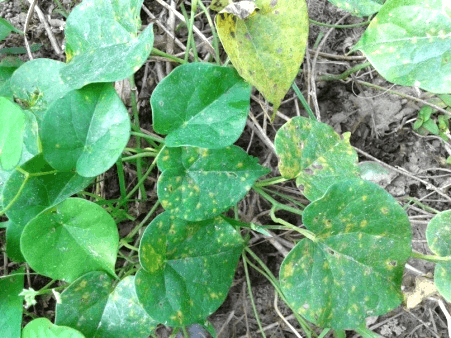 Leaf spot of Gulancha
Leaf spot of Gulancha
(Pathogen: Cercosporella tinosporae )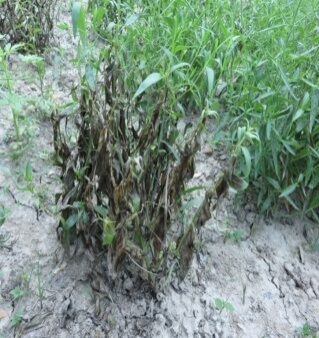 Web blight of Kalmegh
Web blight of Kalmegh
(Pathogen:Rhizoctonia solani)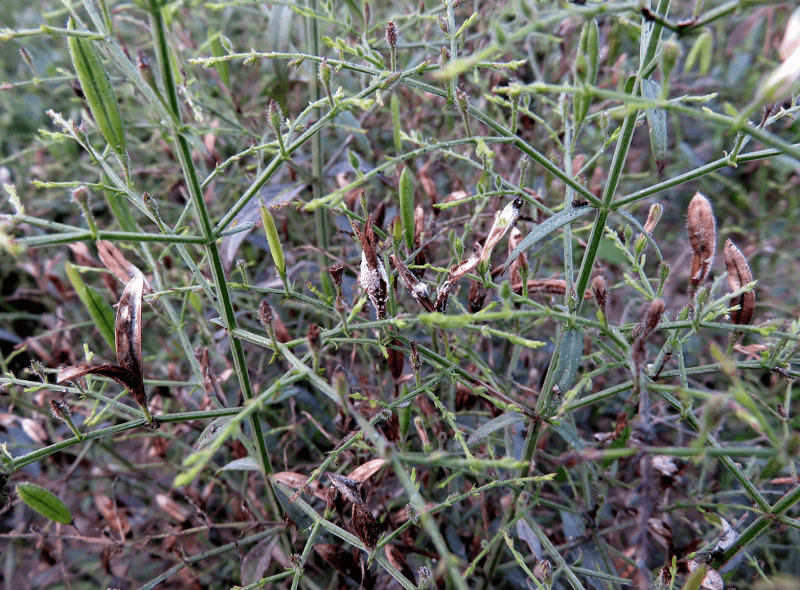 Pod rot of Kalmegh
Pod rot of Kalmegh
(Pathogen:Fusarium sp.)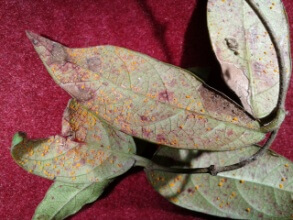 Rust of Black creeper
Rust of Black creeper
(Pathogen: Achrotelium ichnocarpi )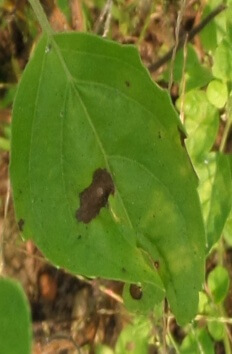 Leaf spot of Tulsi
Leaf spot of Tulsi
(Pathogen: Curvularia sp. )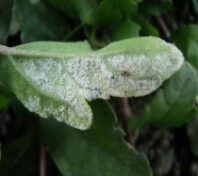 Downy mildew of Bhringaraj
Downy mildew of Bhringaraj
(Pathogen: Plasmopara sp.)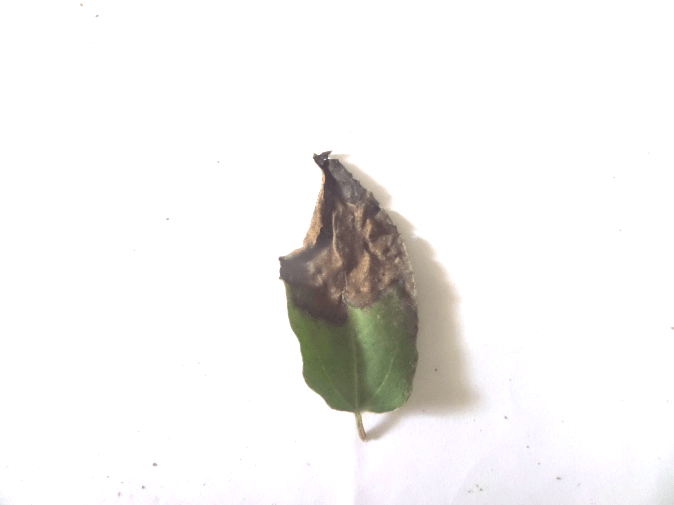 Leaf blight of Ishwarmul
Leaf blight of Ishwarmul
(Pathogen: Rhizoctonia solani )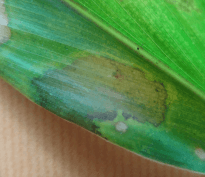 leaf blight Kalo halud
leaf blight Kalo halud
(Pathogen: Rhizoctonia solani )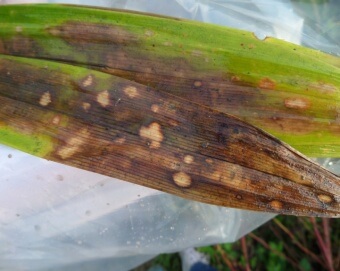 Leaf blight of Annagandha
Leaf blight of Annagandha
(Pathogen: Alternaria sp )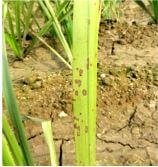 Leaf spot of Bach
Leaf spot of Bach
(Pathogen: Passaloraacori. )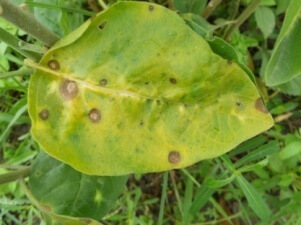 Leaf spot of Ashwagandha
Leaf spot of Ashwagandha
(Pathogen: Cercospora sp.)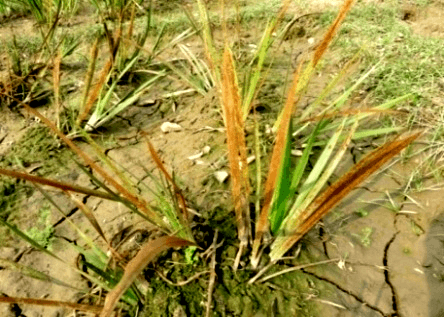 Rust of Bach
Rust of Bach
(Pathogen: Uromycesacori )
Some important insect and mite pests of medicinal plants at Kalyani, WB
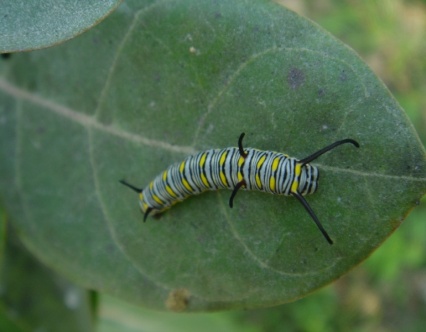 Danaus chrysippus on Calotropes procera
Danaus chrysippus on Calotropes procera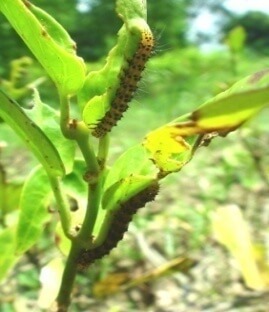 Dichromiasagitta on Tylophora indica
Dichromiasagitta on Tylophora indica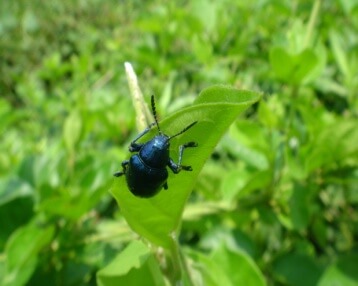 Platycorynus peregrinus on Calotropes sp.
Platycorynus peregrinus on Calotropes sp.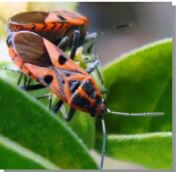 Spilostethus hospes on Withania somnifera
Spilostethus hospes on Withania somnifera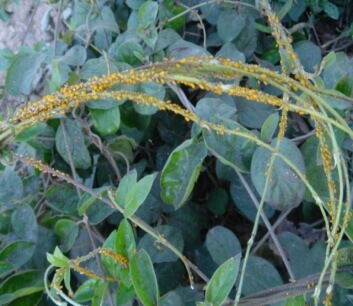 Aphis nerii on Gymnema sylvestre
Aphis nerii on Gymnema sylvestre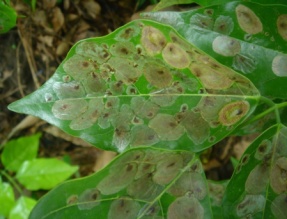 Karanja leaf miner (Acrocercops sp.)
Karanja leaf miner (Acrocercops sp.)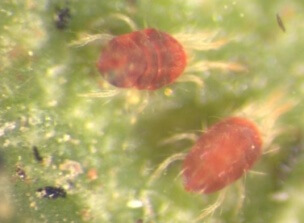 Mite Eutetranychus orientalis on Sarpagandha
Mite Eutetranychus orientalis on Sarpagandha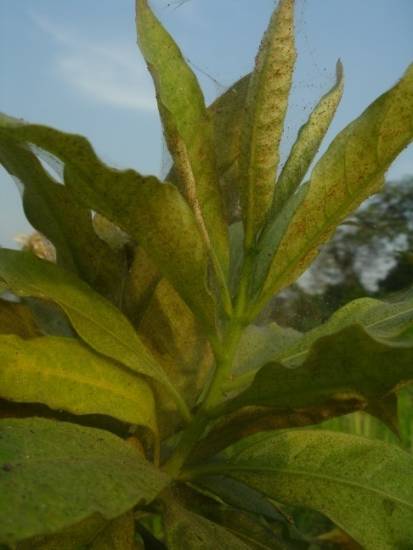 Mite Eutetranychus orientalis on Sarpagandha
Mite Eutetranychus orientalis on Sarpagandha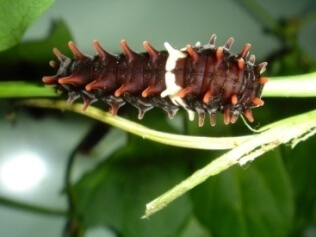 Pachliopta aristolochiae on Aristolochia indica
Pachliopta aristolochiae on Aristolochia indica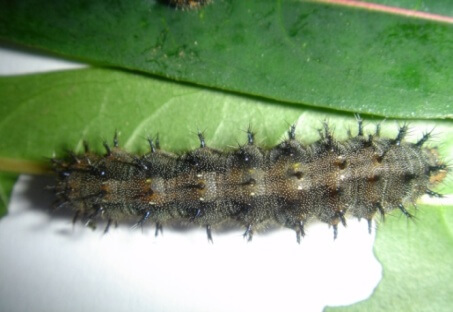 Junonia lemonias on Barleria lupulina
Junonia lemonias on Barleria lupulina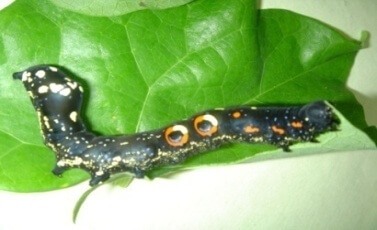 Othreis materna on Tinospora cordifolia
Othreis materna on Tinospora cordifolia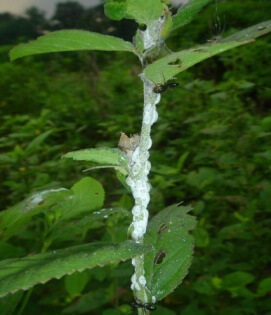 Phenococcussolenopsis on Sida sp.
Phenococcussolenopsis on Sida sp.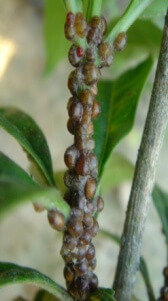 Saissetia coffeae on Sarpagandha
Saissetia coffeae on Sarpagandha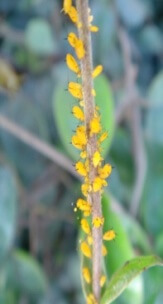 Aphis nerii on Gymnema sylvestre
Aphis nerii on Gymnema sylvestre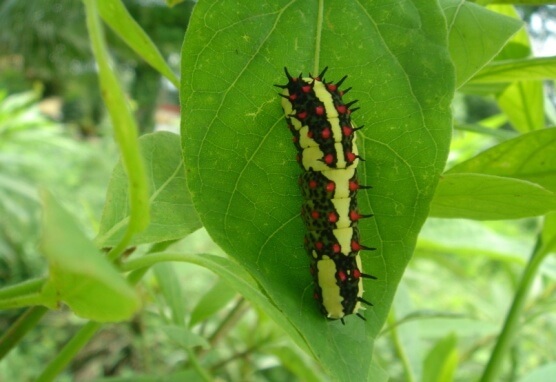 Papilio (Chilasa) clytia (larva & Pupa on Litsea sp.
Papilio (Chilasa) clytia (larva & Pupa on Litsea sp.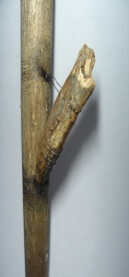 Papilio (Chilasa) clytia (larva & Pupa on Litsea sp.
Papilio (Chilasa) clytia (larva & Pupa on Litsea sp.
- New Pests and parasitoids on Medicinal Plants: Erythrina Gall Wasp (EGW) - Quadrastichus erythrinae Kim (Hymenoptera: Eulophidae) is a new invasive gall inducing pest of Erythina spp. Three new parasitoids have been discovered from galls of EGW found parasitizing larva and pupa of EGW. These belong to genus Aprostocetus (Tetrastichinae: Eulophidae). These three species of Aprostocetus have been described.
New Insect Pests on Betelvine and Medicinal Plants
Aleurocanthus bucktoni Sundararaj & Pushpa Betelvine (Aleyrodidae: Hemiptera)
Galls on Erythrina variegate by Erythrina gall wasp, Quadrastichus erythrinae Kim
- Life history and biology newly invasive Erythrina gall wasp (EGW), Quadrastichus erythrinae Kim (Hymenoptera: Eulophidae: Tetrastichinae):
A new gall inducing insect, Erythrina gall wasp (EGW), Quadrastichus erythrinae Kim (Hymenoptera: Eulophidae: Tetrastichinae) was first reported in West Bengal in 2008.
Q. erythrinae was found widely distributed in West Bengal, inducing galls on the developing new shoot axis, petiole, rachis and leaflet and flower of E. variegata, causing substantial damage to Erythrina plants, sometimes affecting more than 90% of developing shoots. A few hymenopteran insect species other than Q. erythrinae could be recorded from Erythrina galls.
Recommendations at State Level (Variety/ Technologies/Patenting etc):
Variety Development
One clonal selection from Bangla cultivar ‘Ghanagette’ has been identified as high yielder and recommended for release in West Bengal as ‘BIDHAN PAN-1’. This has also been recommended for and recommended for cultivation in the Eastern Region. It is also moderately resistant to major betelvine diseases. It gives 30% more yield over the popular cultivated varieties.
Technologies Recommended
- Recommended Integrated Crop Management (IPM+INM) Module for Betelvine :
- Agronomic Practice:
- Plant population 1.5-1.7 lakh/ha (Spacing, RxR-50-60 cm, PxP-10-15 cm)
- Nutrients: 200kg N of organic form in 4 splits +100kg P2O5 + 100 kg K2O/ ha (Nitrogen from organic sources)
- Irrigation at 3 lit./ sq.m (9-10 times/year)
- Use of Tricontanol (0.05%) thrice at monthly interval after cessation of rains
- Disease Management:
- Sanitation (clean cultivation) + one application of Bordeaux mixture(1%) at pre-monsoon + application of Trichoderma harzianum / viride after one month + one additional application of Bordeaux mixture (1%) two months after first Bordeaux mixture application.
[Rate of application of Biocontrol agent: 5kg culture of Trichoderma harzianum /viride (in broken jowar/wheat) in 500 kg of oilcake for one ha]
- Sanitation (clean cultivation) + one application of Bordeaux mixture(1%) at pre-monsoon + application of Trichoderma harzianum / viride after one month + one additional application of Bordeaux mixture (1%) two months after first Bordeaux mixture application.
- Insect and Mite Pest Management:
- For insect pests particularly, white and blackflies and mealybugs:
Spraying of 5% neem seed extract (50g + 1L Water), Neem oil @ 5ml/litre. Emulsifier like Tween 80, Sandovit, Teepol AG @ 1ml/L or 5g Soap powder should be used with neem seed extract or neem oil at 15 days interval.
Use of Malathion 50EC/ Dichlorvos 76%EC (0.05%) during extreme crisis period. - For Management of Mite:
Wettable sulphur 0.15% or Dicofol 2.5ml/L or Diafenthiuron 50 WP (1g/L) two times 10days interval.
Neem cake @ 2 tonnes/ha is recommended for nematode control in standing crop.
- For insect pests particularly, white and blackflies and mealybugs:
- Agronomic Practice:
- For new plantation, solarization and soil treatment with formalin (pre-planting ) are recommended:
During hot summer, covering of well ploughed land with transparent polythene sheath for one month. During this period, sprinkling of water once in a week in the afternoon by removing the sheath. After one month, drenching the land sufficiently with 40% Formalin diluted in water (1:50) and again covering the land for an other 5 days. New planting should be done one month after the application of formalin.
Other Activities:
- Human Resource Development: M.Sc. & Ph.D. students guided
- M. Sc. students guided: 18 nos.
- Ph. D. Students guided: 9 nos.
- Extension Activities
The AICRP on MAP & BV carried out extension work for transfer of technology to the end users. The scientists provide advisory service to the betelvine farmers as well as extension specialists.
The research findings particularly of Betelvine research have been successfully disseminated to the farmers through publishing and distributing literatures, demonstration trial on farmers’ fields, exhibition in Krishi Mela & Technology Week, publishing popular article in magazines and news papers, attending phone calls, personal visit to farmers’ field and delivering lectures on TV.
Farmers’ Training, Krishi Mela and Farmers’ Field Visit
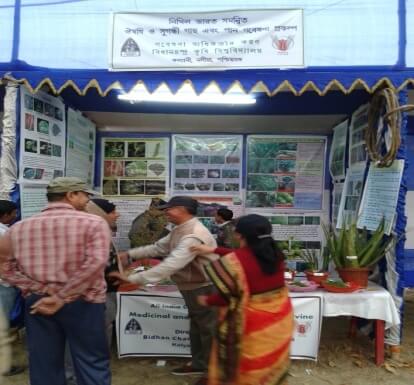 Krishi Mela at KVK, Nadia
Krishi Mela at KVK, Nadia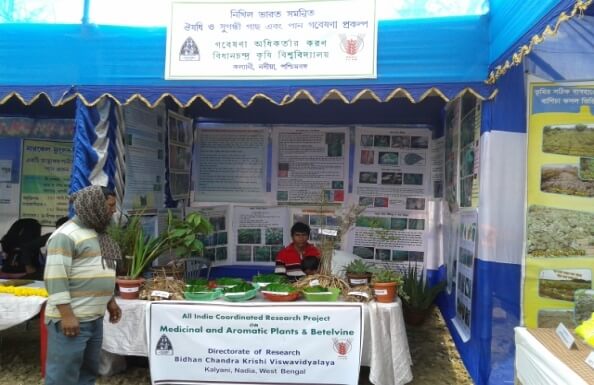 Krishi Mela, F/Hort., BCKV
Krishi Mela, F/Hort., BCKV Field visit at Karimpur, Nadia
Field visit at Karimpur, Nadia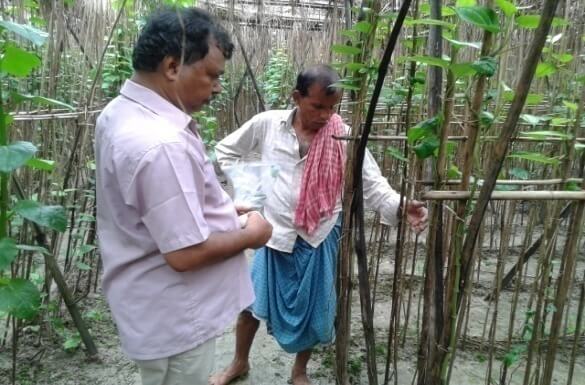 Field visit at Shimurali, Nadia
Field visit at Shimurali, Nadia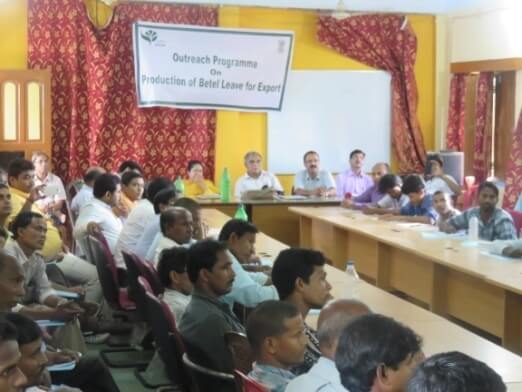 Outreach programme on Production of Betelvine for Export (Kanktia, Purba Midnapur)
Outreach programme on Production of Betelvine for Export (Kanktia, Purba Midnapur)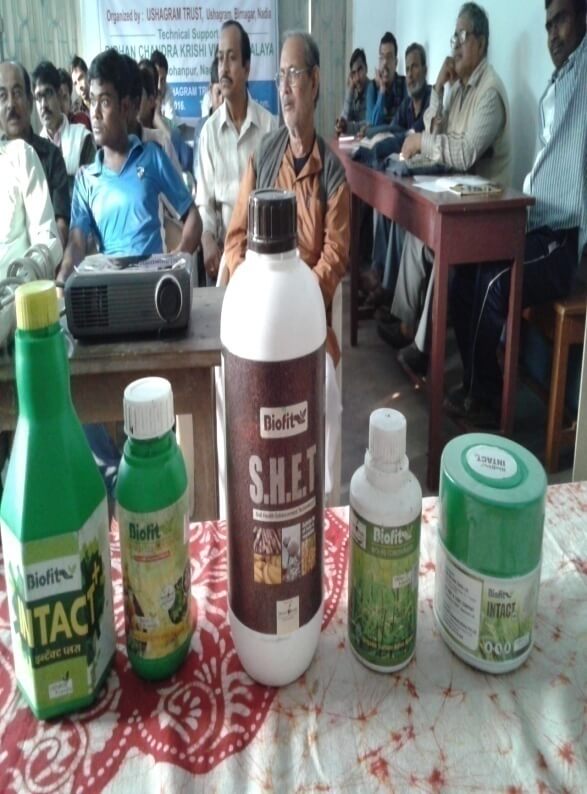 Training programme on cultivation and disease management of Betelvine (Ushagram, Nadia)
Training programme on cultivation and disease management of Betelvine (Ushagram, Nadia)
Field and Laboratory
Visit of dignitaries at Medicinal Plant Garden & Betelvine Borojas
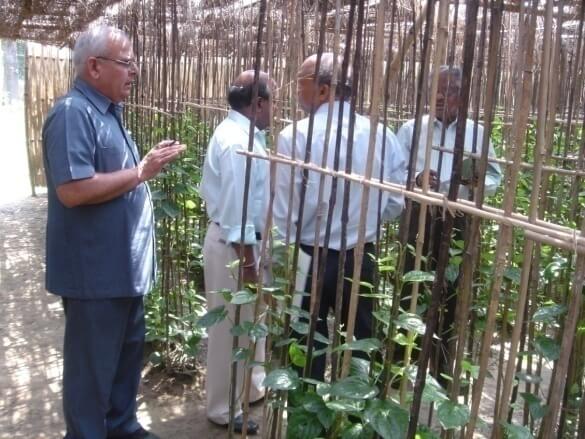 Dr. S Maiti, Ex-Director & PC, DMAPR with QRT Team
Dr. S Maiti, Ex-Director & PC, DMAPR with QRT Team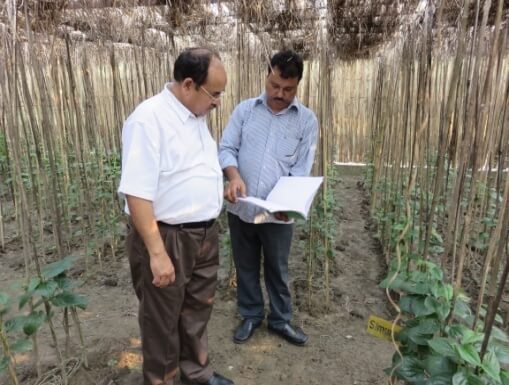 Kumar, Ex-Director & PC, DMAPR
Kumar, Ex-Director & PC, DMAPR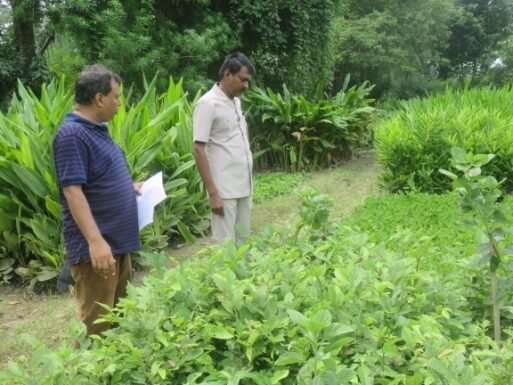 Dr. P. Manivel, Director & PC, DMAPR
Dr. P. Manivel, Director & PC, DMAPR
Achievements:
- New variety: One clonal selection from Bangla cultivar ‘Ghanagette’ has been identified as high yielder and recommended for release in West Bengal as ‘Bidhan Pan-1’
- Design and Development of Permanent Boroj Structure: A new permanent structure of boroja has been developed with concrete basal peripheral and iron angle. Though, initial cost being high, the recurring cost for maintenance is significantly reduced.
- Disease management technology of betelvine has been developed.
- Recorded 35 diseases on medicinal and aromatic plants.
- Recorded 90 insect and mite pests on medicinal and aromatic plants.
- New pests and diseases have been discovered.
- Guidelines for the Conduct of Test for Distinctiveness, Uniformity and Stability (DUS) for Betelvine (Piper betle L.) have been developed.
- Guidelines for the Conduct of Test for Distinctiveness, Uniformity and Stability (DUS) for Kalmegh (Andrographis paniculata) have been formulated.
- Fifty-four cultivars/landraces of betelvine are being maintained at this center. More than twenty-four hybrid lines developed at IIHR, Bangalore are also in the collection.
- The centre maintains an herbal garden with a collection of about 150 plant species of medicinal and aromatic plants including some endangered species.


